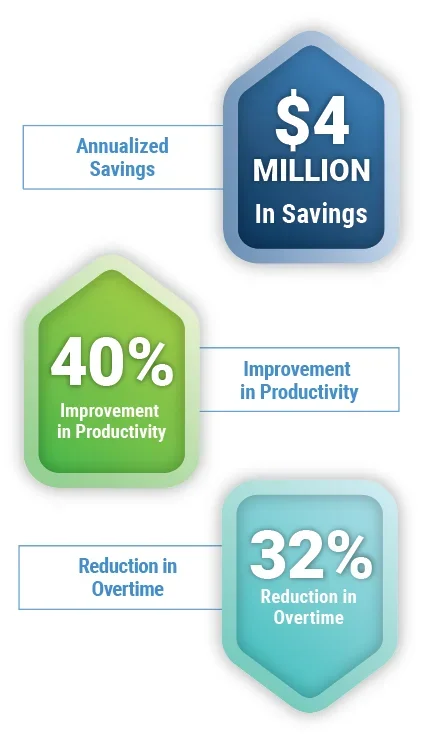

Project Overview

Performance Results
Situation
Despite enjoying a long history of success, the company, a food industry leader and innovator, recently faced a myriad of significant challenges that impeded its growth. Sales had stagnated, and the company struggled to maintain its market position. The pandemic exacerbated existing issues, leading to fluctuating demand, labor shortages, and supply chain disruptions. These factors collectively created substantial operational hurdles, making it difficult for the company to meet its production goals and maintain profitability.
The company’s senior management was operating based on historical performance data rather than the actual current capacity of their plant. This approach masked significant production inefficiencies and resulted in wasted resources and lost time. Additionally, critical skills within the workforce had eroded due to high turnover rates and a lack of investment in training and development. Frontline supervisors were often overwhelmed with daily emergencies, leaving little time to focus on performance improvements. Poor coordination and communication during production line startups further hampered efficiency, leading to frequent delays and suboptimal output.
Analysis
Our comprehensive analysis revealed several critical areas that demanded immediate and focused attention to enhance overall operational efficiency and performance:
- Inaccurate Performance Data: Reliance on outdated performance metrics obscured true production capabilities and inefficiencies.

- Skill Erosion: High turnover and insufficient training investments have led to a decline in essential skills across various departments.
- Daily Firefighting: Frontline supervisors were preoccupied with immediate issues, preventing them from addressing long-term performance improvements.
- Coordination Challenges: Ineffective communication and alignment during production line startups resulted in frequent delays and reduced productivity.
- Maintenance Issues: A reactive "run to failure" maintenance strategy caused significant unscheduled downtime, further reducing efficiency.
- Low Expectations: Senior leadership set performance expectations for frontline managers far below their potential, contributing to underperformance.
- Lack of Investment in People: The absence of structured management processes and training programs hindered the development of a proactive, performance-based culture.
Plan
To overcome these issues, we meticulously planned and designed a comprehensive, multi-faceted strategy that would effectively tackle each challenge and drive sustainable improvements across the organization:
- Cross-Functional Performance Partnership: We established a partnership across all plant departments to enhance communication and execution of daily operations. This collaborative approach ensured that all departments worked towards common goals with clear expectations and accountability.
- Standardized Startup Routines: We created standardized routines to minimize preventable downtime and operator errors. This included detailed checklists and protocols to ensure smooth and efficient production line startups.
- Skill Gap Identification: We conducted a thorough assessment to identify critical skill gaps within the frontline leadership and workforce. This allowed us to design targeted training programs to address these deficiencies and enhance overall competence.
- Capacity Calculation: By calculating the actual operational capacities, we enabled managers to set realistic performance targets and accurately evaluate their teams. This shift from historical data to real-time metrics provided a clearer picture of operational capabilities.
- Behavioral Training: We worked closely with frontline supervisors to train and coach them on new performance standards and necessary behaviors. This included regular workshops and one-on-one coaching sessions to reinforce desired behaviors and practices.
- Problem-Solving Training: We equipped frontline supervisors with decision-making skills to enhance daily performance. This involved teaching them to identify the root causes of issues and implement effective solutions proactively.
- Process Improvement: We trained leaders to recognize and eliminate ineffective processes that historically led to waste and lost time. This continuous improvement mindset aimed to foster a culture of innovation and efficiency.
Implementation Steps:
To effectively address the identified challenges and achieve our performance improvement goals, we followed a structured implementation plan consisting of the following steps:
- Assessment and Planning: Conducted an in-depth, time-sensitive assessment to understand the current state and identify key areas for improvement.
- Engagement and Alignment: Engaged with all plant departments and senior leadership to align goals and ensure everyone was on the same page regarding the changes needed.
- Training Programs: Developed and implemented comprehensive training and development programs to address skill gaps and enhance the capabilities of frontline supervisors and managers.
- Standardization: Standardized key processes and procedures to ensure consistency and minimize variability in production.
- Monitoring and Evaluation: Established a robust monitoring and evaluation framework to track progress, identify issues early, and make necessary adjustments.
Results
The implementation of our strategy led to significant and measurable improvements:
- Cost Savings: The changes resulted in projected annualized savings of over $4 million, contributing to improved profitability and financial health.
- Productivity: Productivity improved by 19%, with some production lines experiencing over a 40% increase. This boost in efficiency allowed the company to meet demand more effectively and improve overall operational performance.
- Overtime Reduction: Achieved a 32% reduction in overtime, resulting in substantial cost savings and better work-life balance for employees.
- Enhanced Leadership: Developed more cohesive, engaged, and better-trained frontline leaders. This enhanced leadership capability led to more effective management and sustained performance improvements.
- Cultural Shift: Fostered a proactive, performance-driven culture within the organization. This cultural shift encouraged continuous improvement and innovation, laying the foundation for long-term success.




